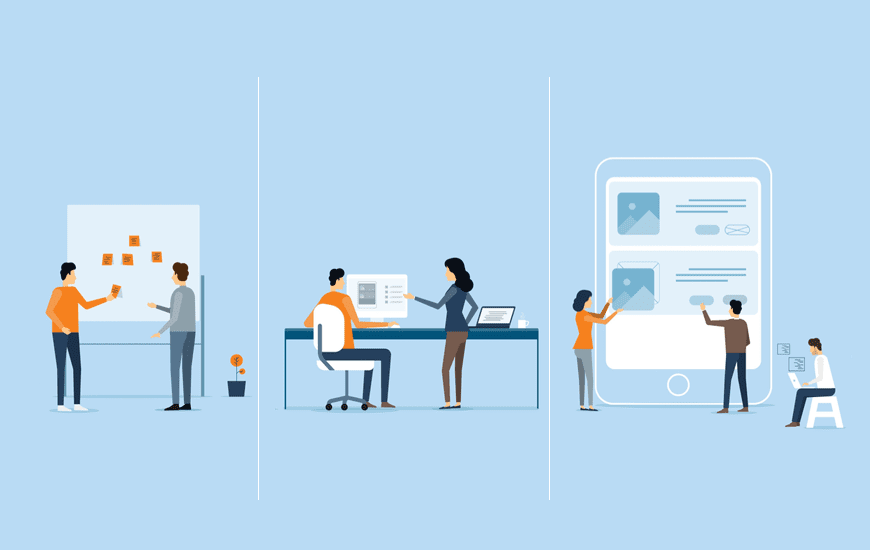Agile methodology for Mobile App Development is becoming increasingly popular due to its numerous advantages compared to traditional waterfall development. By breaking projects into small increments and incorporating continuous user feedback, Agile enables faster releases, greater flexibility, and higher quality apps tailored to customer needs. This article will dive into the many benefits of Agile mobile app development, how it works, and the relevant frameworks in this domain.
What is Agile methodology?
Agile methodology is an approach to software development that emphasizes building products iteratively and incrementally rather than trying to deliver everything at once as a big launch. Agile teams break projects into small, manageable pieces of work, prioritizing the features that offer the most customer value.
Cross-functional teams work closely on short cycles called “sprints” to build, test, and demonstrate working software early and often for stakeholder feedback. Estimates adjust as developers better understand evolving needs. The flexibility to change course and constantly incorporate user input allows for delivering higher quality products faster, matching customer requirements.
Benefits of Agile Mobile App Development.
Faster Delivery
Agile methods focus on splitting work into small, manageable chunks and shipping usable versions often in a matter of weeks rather than doing long release cycles. It leads to significant advantages.
Early & Frequent Working Software Releases
Instead of elaborate specifications, Agile mobile teams concentrate on coding a workable first release covering just key features expected to provide the most value to users. After feedback, they enhance and expand app functionality in short follow-on iterations every two weeks. It enables apps to market much faster and incorporates natural user reactions to steer what gets improved versus theoretical guesswork.
No Lengthy Approvals & Unnecessary Documents
Traditional mobile projects spend excessive time negotiating detailed requirements, writing hundreds of functional specifications pages, and securing resources. Agile cuts this bureaucracy so programmers can start coding solutions immediately using general user stories as guides while product experts readily answer queries daily. It avoids upfront paralysis by analysis and learn-as-you-go flexibility.
Focus On the Toughest Challenges First
Agile mobile teams tackle the most complex problems and foundational features in beginning iterations while complexity seems less overwhelming. Then, build upon those advancing key modules like workflows, integrations, and customizations logically before layering on secondary capabilities.
Excellent Product Quality
Agile development prioritizes building robust, quality mobile apps over meeting arbitrary deadlines. Key methods promoting better quality include:
Early & Frequent Testing Cycles
QA testers work alongside developers daily, testing individual app features versus waiting months after builds are complete. This discovers bugs, compatibility issues, and other defects quicker before problems compound, making fixes exponentially harder. App store certifications happen continuously also rather than risky big-bang submissions.
Incorporate Real User Feedback
Instead of theoretically debating mobile UI design or feature priority guesses, Agile teams release functional builds early to small test groups, measuring feedback quantitatively. Analytics reveal the most/least utilized capabilities and pain points once launched. This accurate user data then guides iterative enhancements that best satisfy market needs.
Fix Identified Bugs Immediately
When defects inevitably emerge, developers halt other efforts to implement fixes during the existing sprint. There’s no need to wait on planned Phase 2 work or mammoth change board backlogs.
Refine Until Users Happy
Agile teams repeatedly demonstrate updated app versions for test groups until achieving high ratings on user satisfaction benchmarks. Unlike traditional projects locked into launch specifications years outdated already, agile mobile apps continuously evolve, staying current and meeting demands in a timely fashion.
Increased Flexibility
Agile processes welcome changing priorities as inevitable in dynamic mobile markets. Key aspects of keeping options open include:
Emphasize Working Software Over Plans
Ever-shifting technologies and user tastes make long-term mobile blueprints unrealistic. Agile doesn’t constrain teams to outdated roadmaps or applicable specification documents. The focus stays on iteratively building the best possible working app matched to present user needs versus forced conformity to old assumptions.
Replan Work Frequently
As business goals or technical hurdles shift for mobile, backlogs, and sprints, realign via recurring plans to redirect where teams should devote time and resources immediately. New capabilities may get prioritized higher, while outdated initiatives get tabled or simplified to make room. There’s no red tape stopping program direction from pivoting on a dime, keeping work focused on what matters most right now.
Test New Ideas Quickly
Bottoms-up innovation from all team perspectives gets evaluated continuously via quick experiments in sprint branches. Developers frequently prototype creative approaches from their initiative alongside finishing assigned user stories. Many ideas get discarded fast without wasting longer investments, while truly promising capabilities merge into main app branches, proving viable.
Improved Collaboration
Agile, mobile advancement relies on teamwork and collaboration rather than siloed work isolation, which is typical of traditional waterfall projects. Some keys to tighter team bonding include:
Open Continuous Communications
Instead of status reports and emailed meeting minutes, everyone shares progress, challenges, and ideas openly in daily standups. Group chat apps facilitate instant clarity among distributed members. Key stakeholders participate in demos and plan to observe the removal of information filters firsthand.
Close Customer Involvement
Rather than tossing specs over the wall to programmers, they must decipher independently; product owners, managers, and user champions remain nearby, answering questions immediately and conveying priority shifts transparently. Early adopter’s customers tested pilot apps directly, providing uncensored feedback about usability struggles and desired enhancements that developers strive to address promptly.
Everyone Contributes Ideas
In Agile, no strict job descriptions constrain creative solutions input. Team members respectfully critique each other’s work in the spirit of collective progress. Quieter personalities get drawn out during reflection retrospectives to share process improvement perspectives without blame. Individual growth through shared ownership makes every contributor shine.
Faster Time-To-Market
Agile mobile practices often slash initial release times by half or more, focusing energy on executing workable solutions rather than theoretical strategy papers. For example:
Cut Bloated Spec Documents
Some old-school mobile projects produce hundreds of detailed requirements and technical spec documents from the conception phase onwards before a single app code line gets written, much less anything demonstrated. Agile cuts through this navel-gazing paralysis, jumping straight to functional foundations weeks faster. There are just enough specs to framework ahead while pivoting as real obstacles are revealed.
Build Only What Users Require
Rather than predetermining every feature imaginable upfront, Agile mobile developers maintain tight feedback loops with real test users to identify must-have capabilities proving most indispensable early on while avoiding over-engineering extra bells and whistles prematurely based on assumptions instead of evidence. MVP baby steps matter most, racing to that viable release.
Add Features Responding To Usage
Initial mobile apps launch targeting the 20% of functionality likely providing 80% of user value, then developers observe actual usage metrics, deciding the following priorities fulfilling the most significant demand, both expanding breadth and maximizing depth where users spend time. This follow-the-trail flexibility keeps apps highly relevant.
Lower Development Costs
Various inherent Agile mobile development traits reduce costs substantially, including:
Saves Rework Costs
Studies show that over half of features built by traditional requirements-driven teams are rarely used in finished mobile applications costing big money. Agile exposes bloat early, preventing wasted coding and complex infrastructure supporting unused capabilities ignored by users. Building less crap saves cash.
Skips Outdated Spec Documents
Producing hundreds of pages of requirements and technical specifications before coding even starts quickly runs $50K+ in lengthy collaborative planning, writing, reviews, and approvals, even if resulting details diverge later from reality. Rapid iterative Agile user stories eliminate this friction while clarifying actual needs faster.
Start Coding Solutions Earlier
With no long specifications phase traditionally delaying actual software construction 4-6 months awaiting approvals, Agile mobile developers begin churning usable prototypes within the initial few weeks of learning by doing. It builds team momentum and confidence in resolving unknowns faster, avoiding costly surprises down the road.
Trim Overengineered “Gold Plating”
Some traditional mobile projects add unnecessary complexity upfront, equating more features to better apps when data frequently proves the opposite. Agile teams instead patiently build only capabilities each iteration that testing confirms users truly find helpful, streamlining simpler solutions while sticking to essential experiences.
Better Control
Agile mobile progress gives teams greater control over work thanks to:
Plan Tasks Themselves
Rather than receiving rigid specifications and assignments from outside product owners, Agile developers review backlogs to select user stories for upcoming sprints playing to their strengths and interests. This sense of bottom-up empowerment and accountability around near-term execution keeps them more engaged in owning successes.
Evaluate Quality Daily
Agile test automation experts collaborate with programmers daily to manually confirm new features working as expected on a continuous basis. Unlike delayed end-phase testing, discovering mobile problems immediately makes adjustments easier before foundations advance too far. Testers guide quality tangibly day-to-day, not just report scorecards afterward.
See Progress Transparently
Both team members and stakeholders receive increased visibility into actual mobile work status from burndown metrics and velocity tracking and frequent functional demonstrations proving actual app capabilities working versus hypothetical documents claiming progress. Realistic milestones confirmed routinely build confidence and identify needs faster.
Improved Customer Satisfaction
Multiple interconnected Agile mobile development elements drive improved user experience and adoption, including:
Fast Bug Fixing
New quality issues get escalated and resolved urgently as soon as identified due to policies minimizing work-in-progress limits to attack defects before proceeding. Compared to traditional milestone testing delays hiding problems for months and requiring security council approvals before eventual fixes make release candidate consideration, this responsive Agile diligence keeps mobile apps reliably fluid.
Deliver Most Valuable Features First
Rather than cramming every possible capability imagined into initial bloated mobile app launches, Agile teams strategically identify the 20% of features likely providing 80% of potential value to target building first. Streamlined experiences consistently outperform everything-but-the-kitchen-sink fatigue.
Incorporate User Feedback
Releasing early app versions to friendly customers helps collect candid qualitative feedback about which capabilities prove most useful, along with pain points requiring refinement. This real-world wisdom from users’ mouths fuels priority decisions, optimizing follow-on additions best satisfying needs.
Improve Quickly
With release cycles tightening from 6-12 months towards 2-4 weeks, impediments slowing mobile enhancement no longer get excuses to fester long without active escalation and answers. Customer frustrations also fade when gratification is weeks rather than months away.
Improved Transparency
Traditional status reporting mechanisms frequently hide actual mobile project troubles until too late. But Agile implements various practices promoting open visibility:
Display Task Board
Printed Kanban boards openly display user stories and details moving through To Do, In Dev, and In Test columns, allowing any observer to gauge workflow bottlenecks quickly at a glance. Making work visible inspires progress, helping teams self-organize optimally.
Show Demos Often
Rather than hiding work-in-progress, teams frequently demonstrate the latest working mobile software, even with known gaps, to gather feedback from users and leadership. Tangible capabilities have proven to visually build confidence and bring overdue features closer to satisfying stakeholders.
Track Data Transparently
Burndown charts, velocity rates, defect rates, and other key Agile data metrics get posted publicly within team spaces, keeping all members accountable to trends. Early warnings into roadblocks or sustainable pace divergence prompt self-corrections, avoiding downstream death marches.
Embrace Change Easily
When external mobile needs shift as they inevitably do, Agile teams can recalibrate priorities more efficiently than traditional projects thanks to:
Work In Smaller Pieces
Monolithic specifications spanning everything upfront before build commitment make pivots computationally impractical. But Agile user stories subdivide desired functionality into bites adjustable separately per release sprint, providing nimble flexibility.
Require Less Documentation
Thicker specifications and technical documents from waterfall development methodology constrain downstream change latitude, requiring heavy revisions to realign objectives. But Agile backlogs outlining capability goals minimize volatile documentation debt, allowing rapid replanning as discoveries unfold.
Encourage Exploration
Developers enjoy allocated innovation time each iteration to experiment with new frameworks or test creative risks that could provide future competitive advantages if promising… without burdensome change controls discouraging fluidity essential for motivating talent attraction retention.

How does Agile methodology for mobile app development work?
Agile mobile development breaks large complex projects into small manageable chunks, prioritizing the most critical features first. Cross-functional teams use short, repeated work cycles called “sprints” to collaborate in implementing planned features and improvements. After each 1-4 week sprint, the team has a working version of the mobile app to demonstrate to stakeholders for feedback.
Based on reactions, they adjust priorities and plans for the next sprint. Each new increment brings the mobile app closer to production release, with the most essential capabilities built first. With constant stakeholder input steering progress, the end product evolves to match user needs precisely. The frequent release cycles also accelerate the incorporation of new trends and code frameworks. Agile mobile teams embrace change, focused less on predicting distant future requirements and more on quickly adapting working functionality to current realities revealed during ongoing development sprints. Continuous deployment reduces launch risks and ensures apps remain relentlessly relevant.
Agile Frameworks
Kanban
- The Kanban board is a visual control system that allows teams to map workflow stages and limit work-in-progress. Moving cards across columns represents progress.
- Standard columns include “To Do,” “In Progress,” and “Done.” Teams focus on finishing items before pulling in new ones.
- Kanban promotes continuous, incremental delivery by controlling work item flow. It improves processes over time by analyzing metrics and making adjustments.
Scrum
- Sprints are consistent 1-4 week cycles for creating releasable increments of a product. The backend work to build features happens within each Sprint.
- Each day, brief Scrum standup meetings have team members quickly describe what they did yesterday, what they will do today, and any blocking issues.
- At the end of Sprints, teams demonstrate the new functionality to stakeholders for feedback before planning the next Sprint.
Lean
- Removing waste through rapid iteration cycles and optimizing value flow improves lead time and quality.
- Teams build Minimum Viable Products first and improve iteratively based on customer feedback.
- Common lean methods include Kanban boards, small batch sizes, limiting work-in-progress, and stopping overproduction.
FDD
- Features are small client-valued functions independent of each other. Modeling plots interactions between features.
- Programmers work in pairs to repeatedly design and build feature sets over 2-week cycles, enabling regular delivery.
- Chief architects, developers, and testers work closely together, focusing on quality through continuous, test-first integration.
XP
- Pair programming: two developers code on one computer, collaborating constantly on the same design, code, or test.
- Writing automated test code supports agile test-driven development before actual functionality gets built.
- Short iterations of 1-2 week sprints enable faster response to rapid change and correct errors.
Final Verdict
As software development continues to take precedence, Agile development principles help teams build higher-quality apps that match user needs more responsively by continuously delivering incremental working functionality. Moreover, it ensures frequent incorporation of customer feedback, empowered self-organizing skilled contributors, and flexibility to adjust directions promptly.
At Canadian Agency, we have a team of expert mobile app developers boasting expertise in Agile Development. With more than a decade of experience in this field, we are ready to help you with your next app development project. If you are interested in our services, contact us now!




